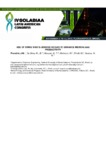Please use this identifier to cite or link to this item:
http://www.alice.cnptia.embrapa.br/alice/handle/doc/1045545| Title: | Use of swine waste-derived biogas to enhance microalgae productivity. |
| Authors: | PRANDINI, J. M.  SILVA, M. L. B. da   MEZZARI, M. P.   MICHELON, W.   PIROLLI, M.   SOARES, H. M.   |
| Affiliation: | JEAN MICHEL PRANDINI, UFSC; MARCIO LUIS BUSI DA SILVA, CNPSA; MELISSA PAOLA MEZZARI, UNOESC; WILLIAN MICHELON, UFSC; MATEUS PIROLLI, UFSC; HUGO MOREIRA SOARES, UFSC. |
| Date Issued: | 2015 |
| Citation: | In: LATIN AMERICAN CONGRESS, 4., 2015, Florianópolis. Anais... Florianópolis: UFSC, 2015. Disponível on line. SOLABIAA. |
| Description: | The effects of swine wastewater-derived biogas on microalgae productivity were determined. Experiments were conducted in a closed photobioreactor containing digestate effluent as culturing media and biogas in the headspaceas source of CO2. Experiments were carried out under mixothrophic and autothrophic conditions. Results showed that autotrophic growth rate (0.6 d-1)was twofoldfaster than mixotrophic. Frequent reinjections of biogas containing up to 2,000 ppm of hydrogen sulfide was not inhibitory to microalgae growth. The rapid removal of H2S in the system suggests photobioreactors can be an interesting alternative to biogas purification. A model to estimate microalgae productivity based on the amount of available CO2, inorganic and organic carbon was developedand showed good data fit correlation (r²= 0.99). |
| NAL Thesaurus: | biofiltration microalgae |
| Keywords: | CO2 H2S Swine wastewater |
| Type of Material: | Artigo em anais e proceedings |
| Access: | openAccess |
| Appears in Collections: | Artigo em anais de congresso (CNPSA)  |
Files in This Item:
| File | Description | Size | Format | |
|---|---|---|---|---|
| final7858.pdf | 463,3 kB | Adobe PDF |  View/Open |









